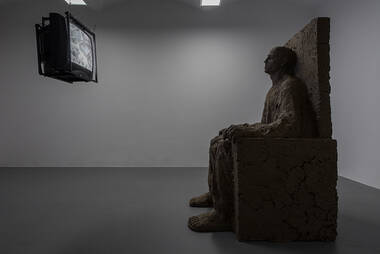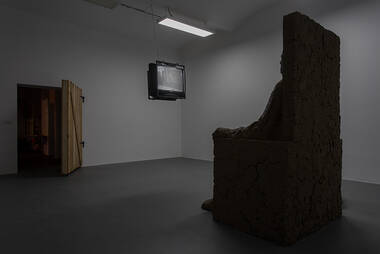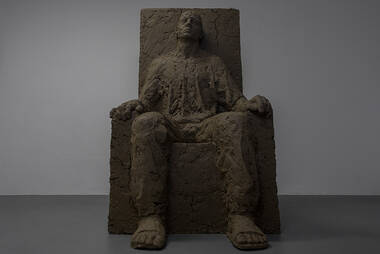Ruslan Vysokikh
Emperor
6. 9. – 29. 9. 2024
EXTENDED: till 6. 10. 2024
opening: 5. 9. 2024 from 6pm
curator: Sláva Sobotovičová
Subconsciously, I Expect Something to Happen
(Ruslan Vysokikh's interview with Sláva Sobotovičová)
SS: Where does the viewer find themselves when they enter the exhibition?
RV: It is a room of a person, of human matter, into which the viewer enters as into a dream. I wanted it to feel surreal: a figure three times the size of a human is sitting there, watching an old television, everything is dark. You look, you concentrate on the details, but everything that's around you doesn't exist. There is no context.
Part of the immersion strategy is the shock of awaking at the end. It's like in the cinema, when I'm immersed in what's on the screen, but then the lights come on and I see that I'm in a theater, that someone is sitting next to me, that it's raining outside... That's somehow traumatic, isn't it?
Yes, a collision with reality. Cinema is a good comparison. You live through the film, and then you wake up and you feel pain - or relief. The moment of entering and exiting a situation is important. I would like to achieve a strong atmosphere, but with minimum resources.
When I asked about the central placement and the position of the installation parallel to the walls, you talked about eliminating dynamics and about detail containing tension.
I'm interested in the twists and turns in the form that suggest movement. Statics is also tension; it poses a challenge. It's quite essential for this project. I want to show something like the fossilization of the soul. When something is rigid, I subconsciously expect something to happen.
You are planning a performative intervention in the installation. Maybe that's a twist too?
I could shape the sculpture at the end of the exhibition. The clay will dry and crack in the meantime. The form will only come when it registers these changes. Clay is important, it can point to what happens to a person who observes the world and does nothing. Passivity may seem like a simpler solution, but it also causes something. I can feel it in myself and it's good to remember that.
With respect to performativity, I want to ask what your presence in the life of a sculpture in general means to you. From your website and your Instagram account, it is clear that it is important for you to document how you manipulate sculptures - that you cast something, add plaster somewhere – through the photo or video we can see you are in a relationship with the sculpture.
For me, the creator is always a part of the thing. I don’t think it always necessarily means something to that thing. Filming of the process is an approximation of the making.
I think it also brings in the memory of what the creator means in art history. For me, it's also about the memory of the craft – we are not drawn to what the sculpture means in the final experience, but to the art environment in a broader sense: much like when we watch documentaries about the making of films, or the backstage preparations prior to a performance.
Yes, it's an attempt to show the making as moments of inspiration, enthusiasm, creative flow. These moments are of course present in the creative process, but the process is lengthy. It is much more digestible when edited in the videos. When you see the production, it puts you in the shoes of the person doing it, including the fact that the creation entails a lot of work, long hours, years of effort, and the collaboration of many people…
I have this childlike reflex of envy with this type of material: 'oh, that's great, to be a sculptor'. Maybe because it's a privilege to make art.
I agree with that, I think about it more and more often. The very subject of the emperor is related to my privilege to create. As a person outside of my country where there is a war going on, I have better possibilities than if I were there. But am I using them enough? Do I even have the right to do what I do when there is a war? The object should be a reminder and a motivation - to do more, to not back down, and to remember that things are not just happening on the screen.
I'm also interested in the fairytale aspect. The Emperor is more of a storybook figure to us now. In this case we have to ask who he is, because it cannot actually be about an emperor.
I think of a Sumerian or Babylonian emperor, a figure holding a small lion... But this is about a person who thinks he has power, but it's the other way around - he's manipulated. The throne is higher than the figure for the purpose of raising the question of which is more important. The fairytale aspect also has to do with magnification - you walk into the room of a giant. It reminds me of a child's feeling that everything is bigger than you.
Do you have a specific strategy in working with scales? Do you size in relation to the room?
Here the proportions are in relation to the room, because it's a little bit bigger than a regular room, but I've been doing larger-than-life sculptures for a long time in different contexts. I've done a whole series of them, each one going somewhat off in its own direction. This will be another one. The scale is also related to the dreaminess I mentioned: the scale determines reality and unreality. It's also a way of generalising the figure: it's not a portrait, but a type, an archetype, as in depictions of workers in architecture under socialism.
I would have expected the enlargement to create a monumental moment, something ritualistic, like contact with another reality, beyond everydayness. It can evoke political, commemorative, or celebratory associations...
I think of the hierarchical perspective in Egypt, for example; the pharaohs are comparatively huge and we know that makes them important. This could be a celebration more in the opposite sense, a kind of monument to passivity. The figure on the throne is meant to inspire awe, but it is cracked and tacked on. It's huge, but fragile. He watches the news and has a lovely sense of knowing everything but doing nothing about it. Plus, it could all be misinformation. I'm also referring to the information war that's taking place around us.
The program of the Jeleni Gallery is possible through kind support of Ministry of Culture of the Czech Republic, Prague City Council, State Fund of Culture of the Czech Republic, City District Prague 7,
GESTOR – The Union for the Protection of Authorship
Media partners: ArtMap, artalk.cz, jlbjlt.net and ArtRevue





